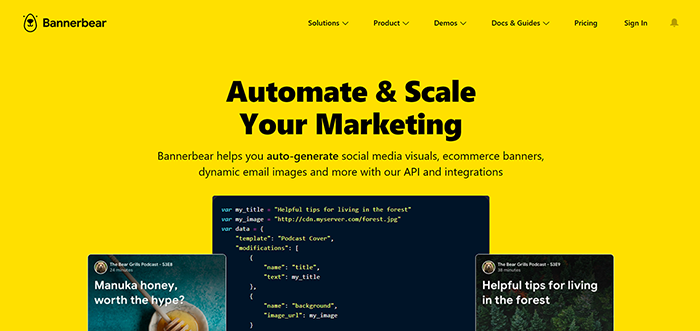With today’s B2B customer having such varied software needs, the software as a service (SaaS) industry is a sandbox for entrepreneurs to experiment with new subscription business models. Over the years, we’ve seen SaaS businesses venture into playing fields such as:
- horizontal SaaS, by designing a product that can be used across virtually all industries (think graphic design platform Canva or accounting software QuickBooks), or
- vertical SaaS, by focusing on creating a niche product for a specific industry (such as Mindbody for the fitness and wellness industry, or eVisit for healthcare).
Traditionally, the goal of most software businesses has been to go big, by building the most powerful, full-featured SaaS product possible. But recently, there’s been an emerging trend of going…micro?
This new breed of micro SaaS entrepreneurs—typically one-person shows—start with a small product, and often want their subscription businesses to stay small. Yet, as you’ll see in this article, a micro product doesn’t necessarily mean micro revenue.
Let’s pull out our magnifying glass to examine how the micro SaaS subscription business model works, and when it might (or might not) be an attractive option for SaaS businesses.
What is micro SaaS?
The micro SaaS subscription models offer a niche product with limited features via the subscription business pricing model. Tyler Tringas, micro SaaS business leader and founder of store locator app StoreMapper, lists the following as typical characteristics of micro SaaS businesses:
- run by a solopreneur or a team of fewer than five,
- bootstrapped,
- operating in a niche market, and
- prioritizes profitability and business stability over growth.
From the product point of view, micro SaaS products are stripped-down, “unbundled” versions of their full-fledged counterparts. The latter pack in tons of features, while micro SaaS products contain only a few select features—for example, a comprehensive route planning application vs. a traffic plugin.
As a result, micro SaaS products often come with more competitive subscription pricing, making them an ideal purchase for the B2B customer that can’t justify paying for a comprehensive feature bundle—especially if they don’t need all these features in the first place.
Micro SaaS products are also great complements to vertical SaaS products. While vertical SaaS businesses go deep to offer an all-in-one product for their industry, they may not have developed features for every need. Micro SaaS businesses develop products to fill these gaps.
Micro SaaS businesses under the microscope
With micro SaaS businesses generally needing less work to operate than the full-fledged alternatives, the barriers to entry to building a thriving micro SaaS business are much lower.
And indeed, there have been many success stories. Just like these two:
Carrd: a simple product can go a long way

The go-to solution for freelancers, solopreneurs, and creatives who want a simple webpage to feature their offerings, Carrd offers “simple, free, fully responsive one-page sites for pretty much anything.”
Pick a web page template, then customize it with your own content and graphics. Unless you need premium features like a custom domain or white-labeling, Carrd is completely free to use.
Carrd is the brainchild of AJ, who launched the product in 2016. As a person who intentionally wanted to keep Carrd a one-man show, AJ was constrained by his ability to add more product features. But these product constraints worked in his favor, as people loved how dead simple Carrd was to use.
By September 2021, AJ had “accidentally” bootstrapped Carrd to $1 million annual recurring revenue (ARR) and three million websites.
Bannerbear: you succeed only when your customers do

Launched in January 2020, Bannerbear provides an API solution for marketers to automatically generate social media, email, and e-commerce graphics. The resulting images are fully customizable, and Bannerbear offers Zapier and Integromat integrations for creating automated image generation workflows.
Jon Yongfook Cockle, the founder of Bannerbear, took a mere six months to double the business’s monthly recurring revenue (MRR) from $10K to $20K. In a reflection post, Jon attributed his achievement to factors such as:
- Adopting a customer-led approach to development; in other words, prioritizing new features based on requests from existing customers,
- Investing in documentation to boost customer usage by educating more customers on his product, and
- Taking a more long-term view of the business by focusing on his long-term customers’ needs as opposed to “freaking out over a churned customer.”
His approach points to a dedication to improving the customer experience, strengthening customer relationships, and nurturing customer loyalty for continued success—which clearly paid off.
Why go micro SaaS?
As we’ve seen, this newfangled micro SaaS business model is definitely a viable one.
And in fact, it may be the more suitable option for SaaS business owners than its tried-and-tested, full-fledged SaaS cousin in these situations:
Start small to learn the ropes
Similar to learning to ride a bike by starting with training wheels, launching a micro SaaS can help first-time founders gain valuable experience in running a SaaS business. At the same time, they stay focused on building a simple product or service well—rather than risking biting off more than they can chew.
When Kevin Michael Gray, creator of micro SaaS WordPress e-signature product WP E-Signature, set out to start his first SaaS business, he initially had much bigger plans. But a CEO friend talked him out of it.
“He made the case: as a new entrepreneur I should start small,” shares Gray. “Grow a micro-SaaS, build a brand, a following, learn how to ‘CEO’ and then launch a significantly larger SaaS platform that can be sold to our micro-SaaS audience.”
Adopting that strategy paid off handsomely for Gray, whose niche WordPress e-signature product has since evolved into a self-hosted platform that provides businesses with a “jaw-dropping” e-signature experience.
Going micro to keep costs down
Other times, entrepreneurs may venture into micro SaaS out of sheer necessity, due to having limited funds and resources at the start. After all, the development costs tend to be a lot more affordable when you’re building a smaller product.
Arnie Singer “didn’t have a big development budget to play with” when he was planning his SaaS product, so he aimed to create his app “for as little money as possible.”
Cue months of planning, and another two to three months of coding on the side. The result was Propfire, a micro SaaS proposal creation product for consultants, freelancers, and small agencies.
When is micro SaaS not the right move?
Despite the potential benefits of the micro SaaS route, this option isn’t for everyone. You might want to forge ahead with a full-fledged subscription-based business model in these scenarios:
When the platform risk is too high
Many micro SaaS products are platform-dependent and designed to complement a specific platform. For example, Twitter screenshot software Pikaso works with only Twitter.
But the platform you’re relying on could one day go poof—taking your micro SaaS’ use case with it. If you aren’t willing to bear this platform risk, then building a bigger, more diversified SaaS product might be more appropriate.
While Steve Lamar could have built his PromoPrep marketing calendar and planning tool as a micro SaaS, he eventually decided on going full-fledged SaaS.
“I considered building the tool within Shopify as a micro SaaS, but didn’t want to limit the capabilities and be completely tied to another platform,” shares Lamar.
“We ended up building integrations to Shopify and Google Analytics to pull data into our platform, which serves a similar purpose as going micro SaaS in our case.”
When your product calls for a team effort
Perhaps you have big dreams for your SaaS business and know operating in a small pond isn’t going to work for you. So you’re willing to up the stakes, and build a full-fledged SaaS product. Go big or go home!
Co-founder and CEO of social media management solution SocialBu, Usama Ejaz, is a big fan of micro SaaS businesses. But he knew that path was not for him.
“I wanted to build a successful company and not just a side business or the key to my own freedom,” he shares. “I wanted to build a company that could generate jobs for other people too.”
And apart from aspirational reasons, Ejaz simply needed more manpower and resources to maintain his extensive business operations. “The one-man or two-man army was not going to be enough in the long run.”
The micro SaaS subscription business model is here to stay
Competition in the SaaS space is tight. To maintain a healthy revenue stream, SaaS businesses will need to be ready to innovate—or even pivot at a moment’s notice.
For some businesses, this may mean changing up their subscription revenue model or reworking their subscription plans after reviewing key metrics. Some businesses may even want to expand their offerings to reach a larger market.
But for some other businesses, micro SaaS may be the way to go. Even with a simple product, scaling and attracting a sizable customer base is possible with product-market fit and the right positioning.
After all, a successful subscription business need not be a large subscription business. Tiny can be mighty.







